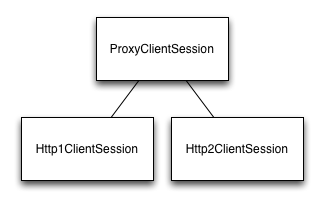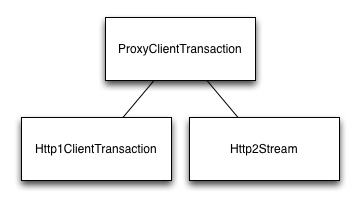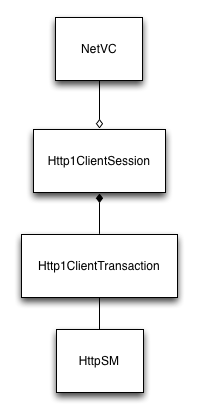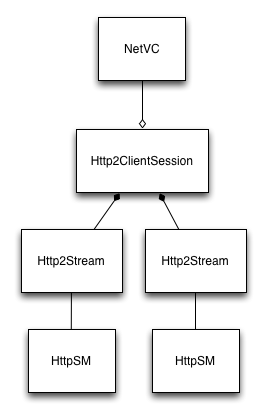An Overview Client Sessions and Transactions
The User Agent interacts with ATS by creating a session with the ATS server and submitting sequences of requests over the session. ATS supports several session protocols including HTTP/1.x and HTTP/2. A HTTP State Machine is created for each request to process the request.
ATS uses the generic classes ProxySession and ProxyTransaction to hide the details of the underlying protocols from the HTTP State Machine.
Classes
ProxySession

The ProxySession class abstracts the key features of a client session. It contains zero or more ProxyTransaction objects. It also has a reference to the associated NetVC (either UnixNetVConnection or SSLNetVConnection). The session class is responsible for interfacing with the user agent protocol.
At this point there are two concrete subclasses: Http1ClientSession and Http2ClientSession. The Http1ClientSession only has at most one transaction active at a time. The HTTP/2 protocol allows for multiple simultaneous active transactions
ProxyTransaction

The ProxyTransaction class abstracts the key features of a client transaction. It has a reference to its parent ProxySession. One HttpSM is created for each ProxyTransaction.
There are two concrete subclasses: Http1Transaction and Http2Stream.
Session Object Relationships
HTTP/1.x Objects

This diagram shows the relationships between objects created as part of a HTTP/1.x session. A NetVC
object performs the basic network level protocols. The Http1ClientSession object has a reference to the
associated NetVC object. The NetVC object is available via the ProxySession::get_netvc() method.
The Http1ClientSession object contains a Http1Transaction object. For each HTTP request, it calls
the ProxySession::new_transaction() method to instantiate the Http1Transaction object. With the HTTP/1.x
protocol at most one transaction can be active at a time.
When the Http1Transaction object is instantiated via ProxyTransaction::new_transaction() it allocates a
new HttpSM object, initializes it, and calls HttpSM::attach_client_session() to associate the
Http1Transaction object with the new HttpSM.
The ProxyTransaction object refers to the HttpSM via the _sm member variable. The HttpSM object refers to ProxyTransaction via the ua_session member variable (session in the member name is historical because the HttpSM used to refer directly to the ClientSession object).
HTTP/2 Objects

This diagram shows the relationships between objects created as part of a HTTP/2 session. It is very similar
to the HTTP/1.x case. The Http2ClientSession object interacts with the NetVC. The Http2Stream object creates
a HttpSM object when ProxyClient::new_transaction() is called.
One difference is that the Http/2 protocol allows for multiple simultaneous transactions, so the Http2ClientSession object must be able to manage multiple streams. From the HttpSM perspective it is interacting with a ProxyTransaction object, and there is no difference between working with a Http2Stream and a Http1Transaction.
Transaction and Session Shutdown
One of the trickiest bits of managing sessions and transactions is cleaning things up accurately and in a timely fashion. In addition, the TXN_CLOSE hooks and SSN_CLOSE hooks must be executed accurately. The TXN_CLOSE hooks must be executed exactly once. The SSN_CLOSE hook must also be executed exactly once and only after all the TXN_CLOSE hooks of all the child transactions have been executed. The CLOSE hooks are important for many plugins to ensure that plugin allocated objects are appropriately reclaimed.
If objects are not cleaned up, memory leaks will occurs. If objects are reclaimed too soon, delayed events may cause use-after-free and other related memory corruption errors.
To ensure that sessions and transactions are correctly shutdown the following assertions are maintained.
The Session object will not call
::destroy()on itself until all child transaction objects are fully shutdown (i.e. TXN_CLOSE hooks are called and the transaction objects have been freed).The Transaction object will not call
::destroy()on itself until the associated HttpSM has been shutdown. InHttpSM::kill_this(), the HttpSM will callProxyTransaction::transaction_done()on the ua_session object. If the user agent initiates the termination, the ProxyTransaction object will send a WRITE_COMPLETE, EOS, or ERROR event on the open VIO object. This should signal to the HttpSM object to shut itself down.